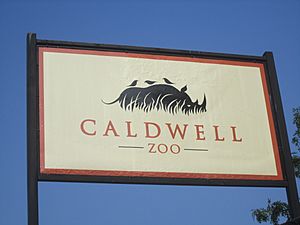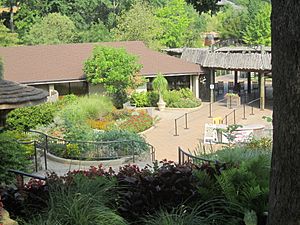Caldwell Zoo facts for kids

Logo
|
|

Front entrance
|
|
| Date opened | 1953 |
|---|---|
| Location | Tyler, Texas |
| Land area | 85 acres (34 ha) |
| Coordinates | 32°22′13″N 95°19′36″W / 32.3704°N 95.3268°W |
| No. of animals | 2,000 |
| Memberships | AZA, WAZA |
The Caldwell Zoo is a fantastic place to visit in Tyler, Texas. It's a large zoo, covering about 85 acres, which is like 64 football fields! Here, you can see over 2,000 animals from all corners of the world.
The Caldwell Zoo is a special place because it's officially recognized by the Association of Zoos and Aquariums (AZA). This means it meets very high standards for animal care. It's also part of the World Association of Zoos and Aquariums (WAZA), connecting it with zoos globally.
Contents
Discovering the Caldwell Zoo
The Caldwell Zoo is home to many amazing animals. You can find everything from towering giraffes to playful African penguins. The zoo works hard to create habitats that feel like the animals' natural homes.
One of the most impressive residents is the largest African elephant in North America! Imagine how big that is. The zoo also has a special "Wild Bird Walkabout" where you can get close to over 400 parakeets and cockatiels.
A Look Back: Zoo History
The Caldwell Zoo started in a unique way. Back in 1937, it began as a Child Development Laboratory. This was a special place for children to learn and grow. David King Caldwell and his wife ran it, bringing in many animals for the kids to enjoy.
The zoo officially opened at its current location in 1953. By 1967, it had grown to include more than 500 animals from 87 different kinds of species.
Growing and Changing
In 1970, something sad happened: the zoo was broken into, and some animals were hurt. This made the children in the area want to help. They collected money to restore the zoo. Their efforts helped the zoo get an African elephant. This event also inspired the zoo to become more modern.
In 1976, the city gave the zoo an extra 40 acres of land. This allowed for a big expansion project. A new home for the elephants was built, and giraffes arrived in 1978.
New Areas and Improvements
The zoo kept growing and adding new sections. In 1983, a 15-acre area opened, showcasing animals native to Texas. The next year, in 1984, new sections for reptiles and an aquarium were added.
Major updates to the African exhibits were finished in 1987. These created large, open areas for animals to roam. Throughout the 1990s, even more improvements were made. In 2002, a new hospital for animals was completed. This included special areas for young animals and a place to keep new animals separate to ensure they are healthy.
Helping Animals: Breeding Programs
The Caldwell Zoo is a proud member of the AZA. This means it takes part in many important breeding projects. These programs help protect endangered animals.
Many baby animals have been born at the zoo. These include reticulated giraffes, colorful flamingoes, black rhinoceros, and even jaguars. The zoo also helped with the first ever cheetah born using artificial insemination. This is a special way to help animals have babies when natural breeding is difficult.
Recently, in January 2014, the zoo welcomed four lion cubs! This was a very exciting event, as it was the first time in 20 years that lion cubs were born at the zoo. African penguins are also being bred, and soon there will likely be more young penguins waddling around.
What's Next for the Zoo?
The Caldwell Zoo has exciting plans for the future! They want to expand into the unused land around the zoo. These plans include building a new aviary (a large bird enclosure) made of glass. They also plan to make even better homes for the animals.
With these expansions, new animals will join the zoo family. One exciting addition will be a colony of playful meerkats.

